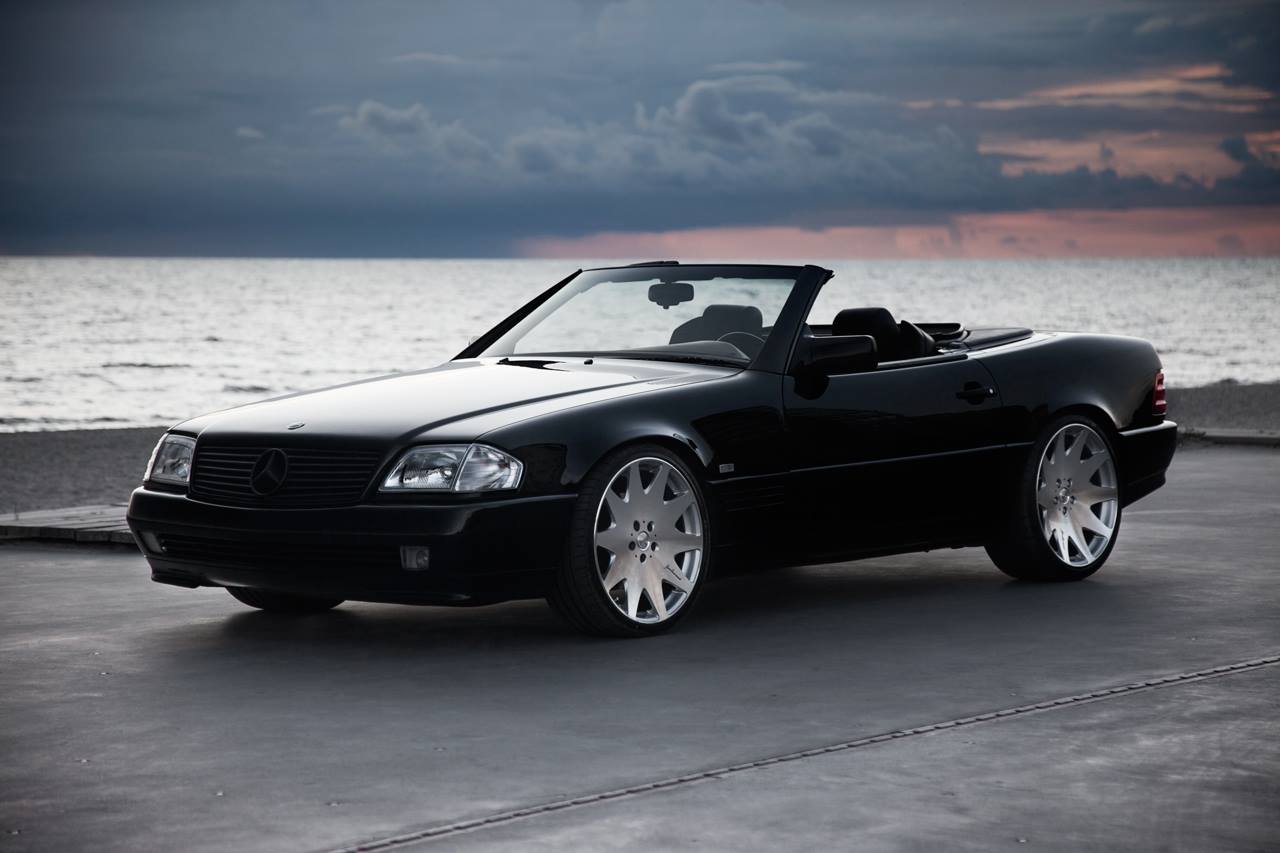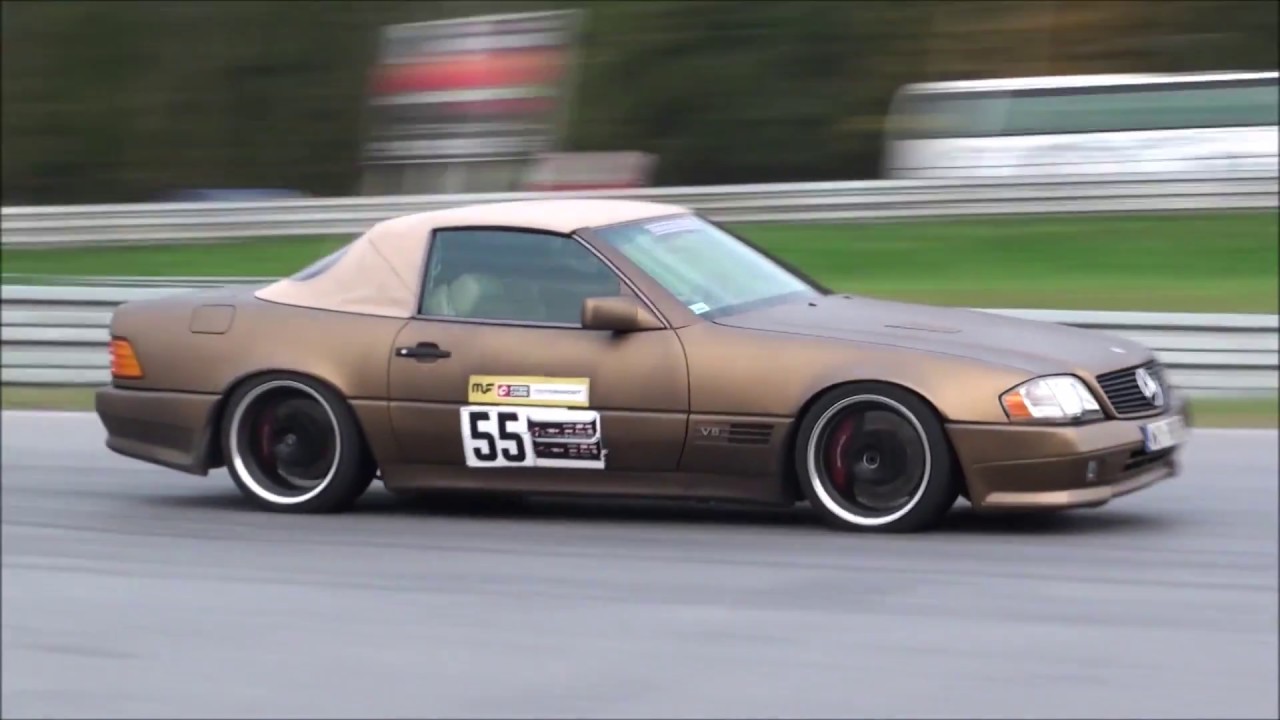Dessa V8or som har inter-namnet M119 satt i fler modeller än R129 SL.
Men inlägget nedan är kopierat av TheR129CO och det är R129 SL som jag fokuserar på.
När man talar om R120 SL så säger nästan alla ”500 SL”.
Trots att de bytte till SL 500 redan 1994 (räknas som 94or).
Och trots att denna M119 motorn fanns i en massa olika versioner, allt från 4.2 liter till 6.5 liter, och även i flera olika versioner som 5.0 liter, så är det just ”den” 5 liters Mercedes V8an som man tänker på när man tänker på en R129 SL.
R129 SL Catalogue: Models, Engines, Colours and Production Numbers
Folk vill säga att M119 motorn är en ”uppgraderad” M117 motor (1971-1991), men nej jag tycker att det skiljer alldeles för mycket för att säga att M119 ”bara” är en moderniserad M117 motor.
Men om vi tar en R107 500 SL från 1988 med M117 motorn och en 500 SL från 1989 med M119 motorn så har R129an 92 mer hästkrafter.
Det får man inte bara genom att ”modernisera” en motor.
Här är vad som står på Wikipedia om skillnaden mellan dessa två motorer.
The M119 differed from the M117 in the following ways:
- The engine block uses asbestos-free gaskets and has better oil flow
- The cylinder head is now a 4-valve aluminium unit with dual overhead camshafts
- The connecting rods are forged and enable cooling of the pistons with sprayed oil
- The pistons are iron-coated cast aluminium
- An improved vibration damper system is used
- The aluminium oil pan has bolted-on oil baffles to prevent foaming of the engine oil
- The intake camshaft timing is adjusted hydro–mechanically up to 20°:
- 0–2000 rpm — retarded for improved idle and cylinder scavenging
- 2000–4700 rpm — advanced for increased torque
- 4700+ rpm — retarded for improved volumetric efficiency
https://en.wikipedia.org/wiki/Mercedes-Benz_M119_engine
Innan jag klistrar in inlägget som jag skulle så vill jag säga ännu en gång att jag gillar verkligen M119 motorn, för att den känns som en V8a.
Jag såg ned lite på den modernare och svagare efterträdaren M113 förr, men det gör jag verkligen inte nu!
Den motorn har imponerat på mig flera gånger nu.
Men den motorn är helt tyst och stilla tills du trycker plattan i mattan, och då verkligen sticker den till!
Så M113 motorn passar perfekt i en sportig lyxbil, absolut.
Men M119 motorn känns som en gammal V8a, på rätt sätt.
Jag vill säga att jag har den bästa versionen av M119 i min 95a med KE-Jetronic, men så har jag de där korkade ”miljövänliga” kablarna som torkar ut av sig själva och den 4-stegade växellådan.
Så i min dröm R129 samling så är där absolut en 96-98 SL 500 också.
Just för att där så har bilarna bättre kablar och den 5-stegade växellådan.
Jag är ofta jättesugen på en äldre R129 just för att jag vill att bilen ska se gammal ut med det gamla AMG kittet.
Jag försöker köpa en äldre SL rätt ofta, men det är inte lätt…
Och ja jag vill ha en R107 SL också..
Nu till inlägget från https://r129.co/our-blog?p=deep-dive-the-m119-engine-from-mercedes-benz

We take a deep dive into Mercedes Benz’ M119 Engine, the legendary powerhouse seen in the R129 SL, W124 E, W140 and C140 S and W210 E, amongst others.
Lets go back to 1989
When the R129 SL first debuted in 1989 the options were three fold:
1) The relatively agricultural 12 valve, single cam, M103-powered 300 SL,
2) It’s peppy twin cam younger sibling, the M104-powered 300 SL 24V,
…both of which were available with a dogleg 5 speed manual gearbox in some markets! A rare find:

R129 with a dogleg manual gearbox. Autotrader
…or your third option:
3) The all new dual overhead cam M119 V8-powered 500 SL.
The powerplant of the latter, the M119 Engine, shall be today’s focus:

The M119 DOHC V8 Engine. Car Throttle
Introducing The M119 Engine
First surfacing in the late 80s, ripe and ready for a fresh decade, the M119 V8 engine was essentially brand new state of the art aluminium cylinder heads bolted onto a very similar (but not identical) block to the outgoing M117 V8, a staple of Mercedes’ product offering since the early 70s. The introduction of this new engine marked the beginning of a very special era for Mercedes’ consumer operations and their racing endeavours alike.

R129 advert from the 90s. Peak Mercedes. Mercedes-Benz Group Media
The M119’s large heads had 4 valves per cylinder (as opposed to 2 for the outgoing M117) and variable valve timing on the intake camshaft, both considerable upgrades for the time. The internals were beefed up with forged connecting rods and cast aluminium pistons. Vastly superior lubrication technologies were also deployed.
The results were monstrous. In its ‘purest’ early form, utilising Bosch’s fairly ancient K-Jetronic (or CIS – Continuous Injection System as it’s known in the USA) mechanical fuel injection system (in its updated electronically-controlled form known as KE-Jetronic), the M119 (119.960)-powered 500 SL churned out 322 horsepower and a whopping 480 Nm of torque fresh from the factory. And they were just the published figures – rumour has it those early cars were often more powerful than the official numbers would have us believe. Well maintained cars are still potently good fun albeit hilariously thirsty, not that that’s a big concern of yours when getting into this type of vehicle.

Another early two-tone R129 with the later monoblock AMG wheels. Collecting Cars
Though KE-Jetronic cars can run to the moon and back with fastidious maintenance, technicians who can tune the mechanical injection system the correct way are becoming fewer and further between. This combined with dwindling parts availability can make the early cars a more daunting proposition.
1993: Second Generation M119 Engine
For the 500 SL’s 1993 model year the second generation M119 V8 was introduced (119.970 – 119.975) having debuted in the first version of the Porsche-engineered W124 500 E.

Mercedes W124 500 E 6.0 AMG, precursor to the post-merger E60. Collecting Cars
The fuel injection system was updated to Bosch LH-Jetronic, a more contemporary digital system that utilised a mass air flow sensor (see our stock) and an electronic slide valve throttle body (see our stock). The mass air flow sensor (or MAF sensor as it’s typically referred to) converts highly precise air mass (or volume) readings into fuel injection quantities via a computer. This made for a more efficient and less thirsty combustion process with, on paper, negligible power losses. Depending on who you ask, it’s the LH system that offers supreme reliability and, if you’re lucky, straightforward maintenance.
By 1996 the R129 SL had matured somewhat, with a handful of incremental updates under its belt. This model year signalled the first major facelift for Mercedes’ flagship vehicle.

A 1996 facelifted R129 SL. Car and Classic
Bosch Motronic: 119.980 – 119.985
Now named the SL 500, as of the 1994 model year redesignation, on top of cosmetic and electronic changes across the board there was another key update to the M119 engine; the introduction of Bosch Motronic (119.980 – 119.985). Though still essentially LH-jetronic, this was now a part of a more compact and integrated fuel and ignition system which featured a modern distributorless wasted spark setup. For many, the final iteration of this engine in Motronic form is the most refined and accessible in terms of maintenance. OBD-II was now mandatory and so digital diagnostics ruled the roost. If you’re in the market for an M119-powered vehicle and are most concerned with reliability, affordable maintenance and comparative peace of mind this may be the one for you.
For the R129s model year 1999, Mercedes introduced the M119’s more basic single overhead cam successor, the M113. A great engine in its own right, but R129 aficionados tend to favour the earlier V8 models.
Use In Racing
The M119 engine’s potential was pushed to the max in a heavily tuned setup for the Sauber C9, a Group C race car sporting two turbos and upwards of 800 horsepower.

The twin turbo M119HL engine used in the Sauber C9. Race Cars Direct
This thing decimated the 24 Hours of Le Mans in 1989:

Sauber C9, the Le Mans winning Group C race car. Classic Driver
How Mercedes built the fastest Group C of the 80s: Sauber C9
A naturally aspirated version of the M119 was used in the CLK LM, a more or less identical twin to the CLK GTR that was developed by Mercedes-Benz and AMG for the FIA GT Championship. A road-legal version was also made. The car won every race in the 1998 FIA GT season, except for the 24 Hours of Le Mans.

CLK LM, the CLK GTRs rarer sibling, powered by a version of the M119 engine. Wikipedia
Mercedes specialist Pierre Hedary speculates that it was the boffins in Affalterbach that provided some of the key inspiration for the M119. The AMG-modified M117 quad cam engine found in some iconic period AMG-converted ‘Hammers’ for example, appears to bear some resemblance.
What is the Mercedes M119 engine and how was it developed?
Mercedes M119 V8 Engine Inspection Part 1: Intro and Air Cleaner Assembly
Där har ni en spellista med 12 videos om M119



[…] Dagens #R129 : Mercedes-Benz M119 V8 Motor […]